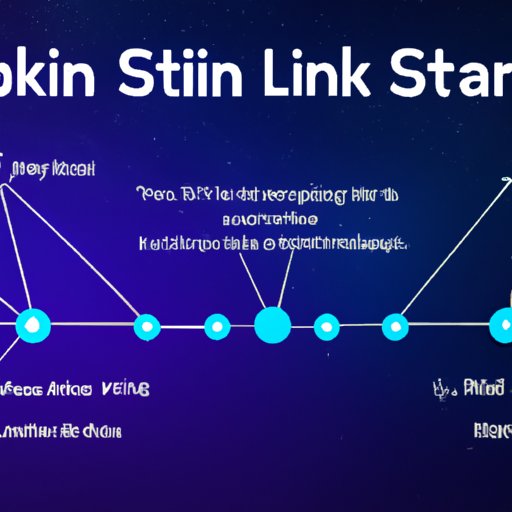Introduction
Starlink is a satellite-based internet service developed by SpaceX, a private aerospace manufacturer and space transportation services company founded by Elon Musk. The goal of this ambitious project is to provide low-cost, high-speed internet access to people around the world, regardless of their location. In order to achieve this goal, SpaceX has launched hundreds of satellites into orbit that form a network capable of providing internet access to any point on Earth.
The purpose of this article is to explore how Starlink works and what makes it possible. We will look at the launch process, network infrastructure, and the technology behind it, as well as examine the potential impact of Starlink on global internet accessibility. By the end of this article, you should have a better understanding of how Starlink works and why it is so revolutionary.
A Step-by-Step Guide to Understanding How Starlink Works
In order to understand how Starlink works, we must first look at the launch process. Every two weeks, SpaceX launches 60 satellites into orbit aboard a Falcon 9 rocket. These satellites are then deployed in a series of orbits, forming a mesh network of interconnected satellites. This mesh network is what enables Starlink to provide internet access to any point on Earth.
Once in orbit, the satellites communicate with each other using lasers and radio frequencies. This allows them to form a wide area network (WAN) that covers an entire continent. Each satellite is equipped with multiple antennas that allow it to communicate with other satellites and ground stations. This creates a network infrastructure that is capable of delivering high-speed internet access to any location on Earth.
The key components of the Starlink system include the satellites, ground station network, and onboard computers. The satellites are responsible for relaying data between the ground stations and users. The ground station network consists of multiple antennas and receivers located around the world that receive data from the satellites. Finally, the onboard computers are responsible for controlling the satellites and processing data.
Exploring the Technology Behind Starlink: What Makes It Possible?
In order for Starlink to be successful, SpaceX had to develop several new technologies. One of these is the satellite design, which features a unique shape and weight distribution that allows it to remain stable in orbit. These satellites are also equipped with powerful solar arrays that provide enough power to keep them operational for years.
The ground station network is another key component of the Starlink system. This network consists of multiple antennas and receivers located around the world that receive data from the satellites. This allows the system to provide high-speed internet access to any location on Earth.
Finally, the onboard computers are responsible for controlling the satellites and processing data. These computers are powered by cutting-edge software that is able to quickly process large amounts of data and ensure that the system is operating efficiently.
The Anatomy of a Starlink Satellite: A Closer Look
The Starlink satellites are designed to be lightweight and durable. They weigh about 227kg and measure 4m x 1.1m x 1.0m. Each satellite is equipped with two solar arrays that provide enough power to keep them operational for up to five years. The satellites also feature multiple antennas and receivers that allow them to communicate with each other and the ground station network.
The communication equipment onboard the satellites is state-of-the-art. It consists of laser intersatellite links (LISLs) and radio frequency (RF) transceivers. The LISLs allow the satellites to communicate with each other and form a mesh network, while the RF transceivers allow them to communicate with the ground station network.

Examining the Network Infrastructure of Starlink
The network architecture of Starlink consists of four layers: the satellite layer, ground station layer, terrestrial layer, and user layer. The satellite layer consists of the satellites themselves, which are responsible for relaying data between the ground stations and users. The ground station layer consists of multiple antennas and receivers located around the world that receive data from the satellites.
The terrestrial layer consists of the fiber optic cables and routers that are used to transmit data from the ground stations to the users. Finally, the user layer consists of the devices that are connected to the internet, such as smartphones, laptops, and tablets.
Data transmission is handled by an advanced protocol called the User Datagram Protocol (UDP). This protocol allows the satellites to send and receive data quickly and reliably. It also ensures that the data is delivered without any errors or delays.
The reliability of the Starlink system is ensured by a sophisticated error correction system. This system monitors the health of the satellites and can detect any potential problems before they become serious. If any issues are detected, the system can automatically switch to another satellite in order to maintain a reliable connection.

How Starlink Is Revolutionizing Global Internet Accessibility
Starlink has the potential to revolutionize global internet accessibility. The system is currently in beta testing and is available in certain areas of the United States, Canada, the United Kingdom, Germany, and Australia. However, SpaceX plans to expand coverage to other countries in the near future.
One of the most exciting aspects of Starlink is the cost. The service is priced competitively, making it more accessible than other internet providers. Additionally, the service is incredibly fast, with speeds of up to 100Mbps reported in some locations.
Starlink is also revolutionizing global internet accessibility in other ways. The system is capable of reaching remote locations that would otherwise be difficult to connect to the internet. This means that people in developing nations who lack access to reliable internet can now get online and take advantage of the many benefits that come with it.

An Overview of Starlink: What It Is and What It Means for the Future of Connectivity
Starlink is a revolutionary system that has the potential to revolutionize global internet accessibility. By providing low-cost, high-speed internet access to people around the world, regardless of their location, it has the potential to bridge the digital divide and bring people closer together. Additionally, it could open up new opportunities for businesses and other industries.
However, there are still some challenges ahead for Starlink. For one, the system is not yet fully operational and coverage areas are limited. Additionally, there are concerns about the potential environmental impact of launching thousands of satellites into orbit. Despite these challenges, Starlink is an exciting project with the potential to transform global internet accessibility.
Conclusion
Starlink is an ambitious project with the potential to revolutionize global internet accessibility. By providing low-cost, high-speed internet access to people around the world, regardless of their location, it has the potential to bridge the digital divide and bring people closer together. Additionally, it could open up new opportunities for businesses and other industries.
In order to understand how Starlink works, we must first look at the launch process, network infrastructure, and the technology behind it. We must also explore the potential impact of Starlink on global internet accessibility. By the end of this article, you should have a better understanding of how Starlink works and why it is so revolutionary.
(Note: Is this article not meeting your expectations? Do you have knowledge or insights to share? Unlock new opportunities and expand your reach by joining our authors team. Click Registration to join us and share your expertise with our readers.)
